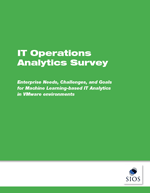Date: February 16, 2017
Tags: #AIOps, IT operations analytics, root cause analysis, VMware performance
This is the first post in a two-part series. We are highlighting how AIOps is changing IT performance optimization. The original text of this series appeared in an article on Information Management.
During the next two years, companies are set to spend $31.3 billion on cognitive systems tools. Today, companies are using tools based on these technologies (i.e., data analytics and machine learning) to solve problems in a wide range of areas. For example, companies are using artificial intelligence (AI)-powered customer service bots and trucking routes that data scientist design. Ironically, information technology (IT) departments have not yet fully leveraged the power of machine-learning based analytics — IT.
Survey Shows More Critical Apps in VMware
Howe ver, that is changing because IT environments are becoming increasingly complex. They are moving from physical servers to virtual environments. According to a recent study from SIOS Technology, 81 percent of IT teams are running business-critical applications in VMware environments.
ver, that is changing because IT environments are becoming increasingly complex. They are moving from physical servers to virtual environments. According to a recent study from SIOS Technology, 81 percent of IT teams are running business-critical applications in VMware environments.
Virtual environments are made up of components, such as VMs, applications, storage and network that are highly interrelated and constantly changing. To manage and optimize these environments, IT managers have to analyze an enormous volume of data. They learn the patterns of behavior between component. This lets them accurately correlate application service issues to the root cause of the problem in the virtual environment. As a result, a new field has emerged – AIOps.
What is AIOps?
AIOps (algorithmic IT operations platforms) is a new term that Gartner uses to describe the next phase of IT operations analytics. These platforms use machine learning and deep learning technology to automate the process of finding performance issues in IT operations.
Right now, Gartner estimates only five percent of businesses have an AIOps platform in place. However, more businesses will adopt these platform during the next two years, bringing that number to 25 percent. Importantly, AIOps replaces human intelligence with machine intelligence. It deciphers interactions within virtual IT environments. Consequently, they can uncover infrastructure issues, correlate them to application operations problems and recommend solutions.
AIOps platforms use machine learning to understand how these environments behave over time to identify abnormal behavior. Furthermore, IT can even use AIOps platforms to find and stop potential threats before they become application performance issues.